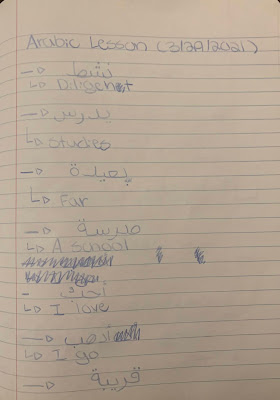Day 4!
To start off the fourth day of my A-Term, I once again began with my daily lessons.
Today, we started off with a whole new lesson, which was about the different versions of "I am" based on whether it was feminine or masculine. This lesson was probably one of the hardest ones so far, since the grammar and sentence structure for this vocabulary was very different to how it is in English.
Ms. Samira first made a table of each word: "You are (Masculine), You are (Feminine) and I am" to help me learn each word in an easier way.
Both "You are" masculine and feminine are when you're referring to a person directly, or if you're talking to them about something that they own/possess. For example, if you're talking to your sister you would say: "أنت اسمكِ", which means "Your name (Feminine)". This would be the same if you were talking to your brother, except it would be "أنتَ اسمكَ", with a line at the top of the kaf and taa instead of a line at the bottom.
In addition to "You are", I also learned about the way in which "She is" and "He is" are used in Arabic, which was equally as difficult as the previous lesson. Both "She is" and "He is" use the same letter in the beginning of the word, but they end and sound differently from each other. "She is" is spelled "هي", while "He is" is spelled "هو".
This definitely took a bit for me to grasp, but it definitely made a lot more sense by the end of the lesson with Ms. Samira's help and explanations.
The last thing I learned about was changing different words from masculine to feminine, by adding the letter "ة" to the end of the word. I learned that you have to add "ة" to the end of a word to make it feminine, and you don't add it when it's masculine.
To help me further understand both lessons, Ms. Samira and I looked at a conversation in the book we've been using throughout this A-Term, which also helped introduce some new vocabulary to me.
After finishing up my Arabic lesson for the day, I finished the fourth day of A-Term!





Comments
Post a Comment